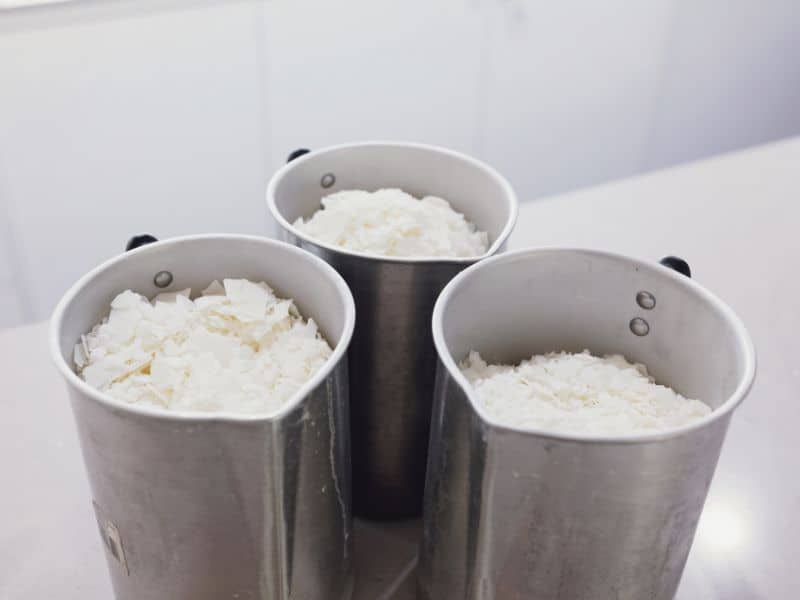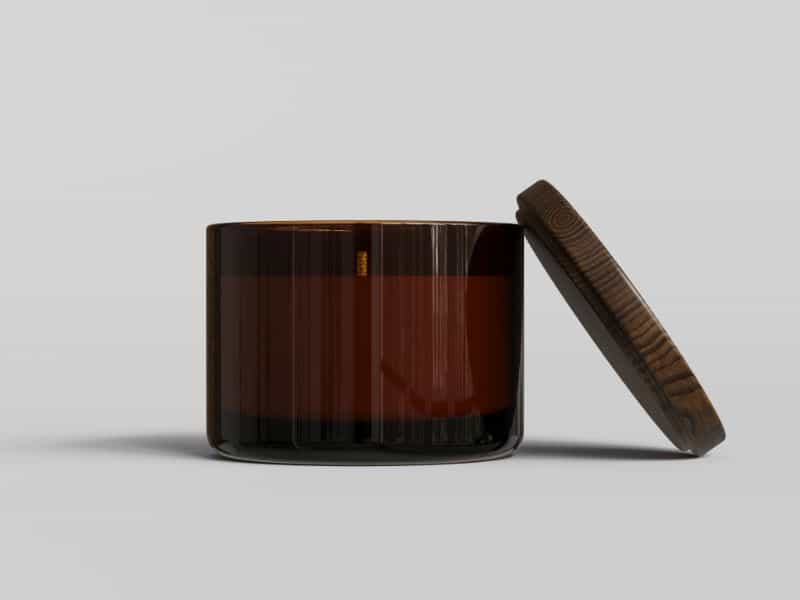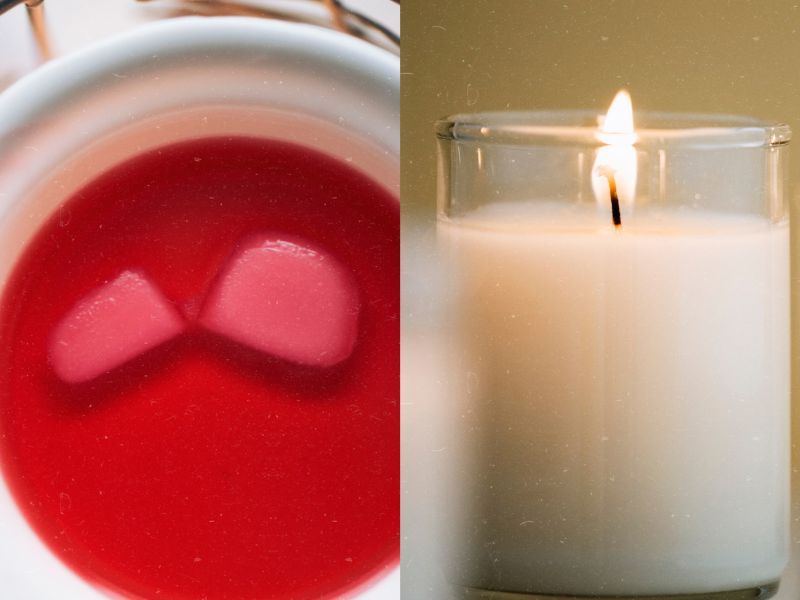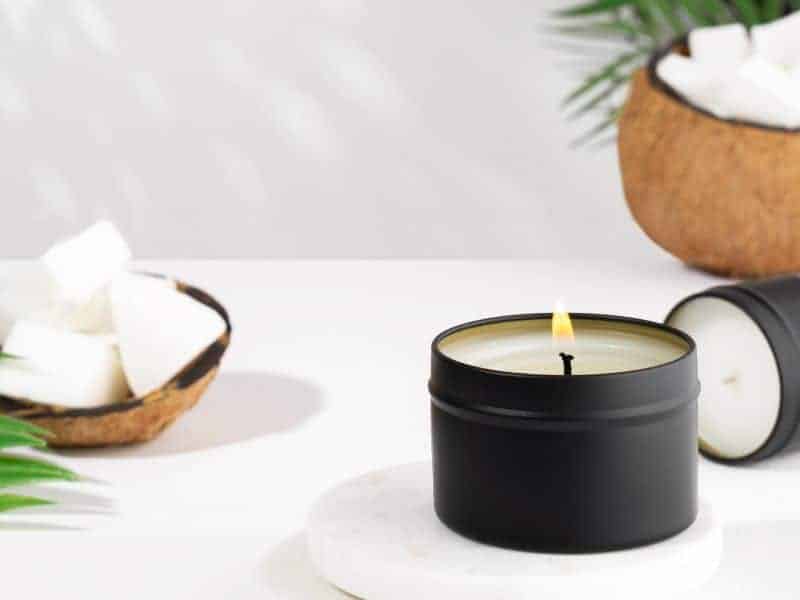Candles can be a pain to figure out when you are just getting started. This article is designed to help you learn how much wax is needed for your candle-making projects.
It’s crucial to understand the difference between wax weight and wax volume. Wax weight refers to how much it weighs on the scale, while wax volume is the space it occupies. Measuring wax by weight is more accurate and consistent for candle making.
Wax density plays a key role in determining how much wax you need. Since wax is less dense than water, it occupies more space for the same weight. Additionally, different types of wax have slightly varying densities, affecting the amount needed for a specific candle size.
This means if you fill a container up with water and weigh it, and fill the same container up with wax and weigh it, it will weigh less holding wax.
To ensure consistent wax levels in your candles, mark fill lines on the containers you’re using. This helps you know when you’ve added enough wax, resulting in candles with a uniform appearance. Fill lines are especially useful for beginners and when creating candles in batches.
How Much Wax Per Candle
The amount of wax per candle will depend on what size the candle container is. To help you out with some common container sizes we have created a helpful table to get you started.
This table shows how much wax you might need for some popular candle container sizes.
| Candle Tin Size (oz) | Wax Weight (oz) | Wax Weight (grams) |
| 4 oz | 3.2 | 90.7 |
| 6 oz | 4.8 | 136.1 |
| 8 oz | 6.4 | 181.4 |
| 10 oz | 8.0 | 226.8 |
| 12 oz | 9.6 | 272.2 |
Once you’ve gained some experience you will want to do the calculations yourself to get your measurements perfect. This can all change slightly based on your fragrance load and the type of wax you are using.
How To Measure Candle Wax
A key aspect of successful candle making is accurately measuring the candle wax. In this section, we will discuss why container labels can be misleading, the importance of measuring by weight, and the role of digital scales in achieving precise measurements.
Always measure candle wax by weight. Measuring candle wax by weight ensures accuracy and consistency, as different wax types have varying densities. It also allows for precise calculations when adding dyes or fragrances, resulting in better-quality candles.
Containers don’t hold what they say
Candle containers come with specific volume measurements such as 4 oz, 6 oz, or 8 oz. However, as we’ve already covered, these measurements can be misleading, as they often refer to the container’s liquid capacity.
When using wax, which is less dense than water, the actual amount of wax needed to fill the container will be a smaller number.
As a result, it’s essential to rely on accurate measurements rather than container labels.
Always measure by weight
Measuring wax by weight ensures consistency and precision in your candle making process.
Since wax and water have different densities, measuring by volume can result in an incorrect amount of wax. By measuring wax by weight, you can achieve consistent and predictable results, regardless of the wax type.
Additionally, measuring by weight allows for easier calculations when adding dyes or fragrances to your candles.
Digital scales are important
Investing in a digital scale is crucial for accurate and consistent wax measurements. Digital scales provide precise readings, helping you avoid errors that could negatively impact the quality of your candles.
When selecting a digital scale, choose one that measures in both ounces and grams, as different wax suppliers may provide measurements in either unit.
A reliable digital scale will ensure you have the correct amount of wax for each candle, improving the overall quality and appearance of your finished products.
Determining Wax Amount & Final Calculations
Accurately determining the wax amount is essential in candle making.
Follow these steps for calculating total wax and fragrance oil:
- Choose fragrance load: Typically 3-10%, with 6% being common. This depends on the wax type and desired scent strength.
- Note wax is 86% the density of water: A container holding a certain water volume will hold less wax (by weight).
- Find the container’s water weight: Fill the container with water and weigh it using a digital scale.
- Calculate wax weight: Multiply water weight by 0.86, considering the density difference between water and wax.
- Multiply by the number of candles: Multiply the wax weight per container by the number of candles being made.
- Calculate fragrance load: Multiply the total wax weight by the chosen fragrance load percentage.
- Subtract fragrance weight from wax weight: This gives a more accurate fill for containers, avoiding leftover wax.
- Add wax and fragrance weights: This gives the total weight needed for each candle.
Calculation Examples
Example 1
For 5 candles at 10 oz each, calculate wax (50 oz x .86 = 43 oz of wax).
Calculate the fragrance load (43 oz wax x 6% = 2.58 oz fragrance oil).
Subtract fragrance weight from wax weight (43 oz – 2.58 oz = 40.42 oz wax).
Use a final wax total of 40.42 oz and add fragrance weight (40.42 oz + 2.58 oz = 43 oz).
Divide the total weight by the number of candles (43 oz / 5 = 8.6 oz per container).
Example 2
For 6 candles at 8 oz each, calculate wax (48 oz x .86 = 41.28 oz of wax).
Calculate the fragrance load (41.28 oz wax x 6% = 2.48 oz fragrance oil).
Subtract fragrance weight from wax weight (41.28 oz – 2.48 oz = 38.8 oz wax).
Use a final wax total of 38.8 oz and add the fragrance weight (38.8 oz + 2.48 oz = 41.28 oz).
Divide the total weight by the number of candles (41.28 oz / 6 = 6.88 oz per container).
Tips for Measuring Wax
Achieving accurate wax measurements is crucial for creating high-quality candles. Follow these tips and recommendations for measuring wax, melting, pouring, and ensuring safety during the process.
Using a kitchen scale
A digital kitchen scale is an essential tool for measuring wax accurately. Ensure your scale measures in both ounces and grams to accommodate different wax suppliers’ units.
Place a clean, dry container on the scale, tare the weight, and then pour the wax into the container until the desired weight is achieved.
Measuring by weight guarantees consistent results, especially when adding dyes and fragrances.
Melting and pouring
When melting wax, use a double boiler or a heat-safe container placed in a pot of simmering water. This method ensures even heating and prevents the wax from overheating.
Monitor the wax temperature with a thermometer, aiming for the manufacturer’s recommended melting point. Once the wax reaches the desired temperature, remove it from heat and add dye and fragrance, if desired. Stir gently but thoroughly to ensure even distribution.
Allow the wax to cool to the suggested pouring temperature before carefully filling your candle containers.
Safety precautions
Safety is paramount when working with hot wax. Always wear heat-resistant gloves and eye protection to prevent burns or injuries. Keep a fire extinguisher nearby, as wax is flammable.
Never leave melting wax unattended and avoid using high heat, which could cause the wax to ignite. Work in a well-ventilated area to avoid inhaling fumes from the melting wax or added fragrances. Keep children and pets away from your workspace, and ensure all materials are securely stored when not in use.
Following these safety guidelines will help protect you while creating beautiful candles.
Frequently Asked Questions
Measuring wax by weight ensures accuracy and consistency, as different wax types have varying densities. It also allows for precise calculations when adding dyes or fragrances, resulting in better-quality candles.
Use a double boiler or a heat-safe container placed in a pot of simmering water to ensure even heating and prevent overheating.
Fill the container with water to the desired level and weigh it using a digital scale. This will provide you with the container’s water weight, which will help you calculate the wax weight needed.
A digital kitchen scale that measures in both ounces and grams is recommended for accurate wax measurements.
Conclusion
In conclusion, understanding how to measure candle wax accurately is crucial for creating high-quality candles with the desired fragrance load and appearance.
By using a digital kitchen scale, accounting for wax density, and following safety precautions, you can ensure consistent results and produce beautiful candles.
By mastering these techniques, you can confidently embark on your candle-making journey and enjoy the calming ambiance and delightful scents your creations bring to your home or as thoughtful gifts for loved ones.






